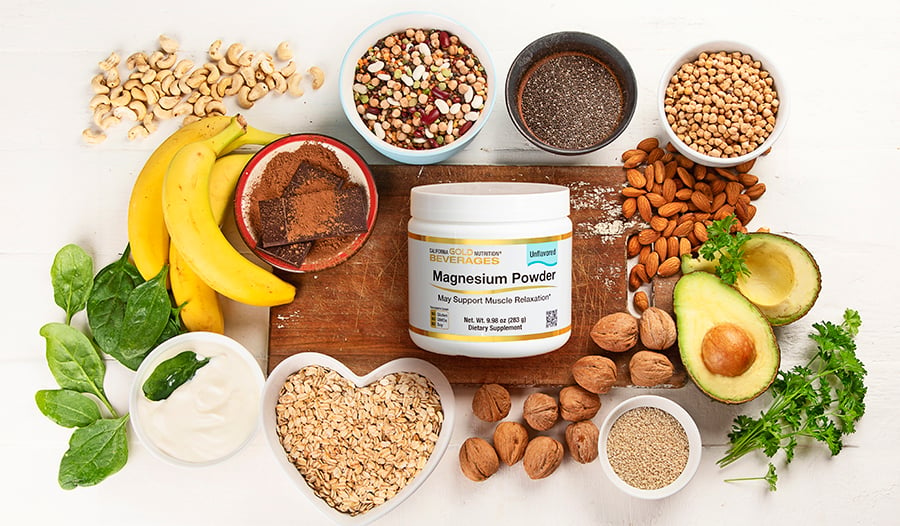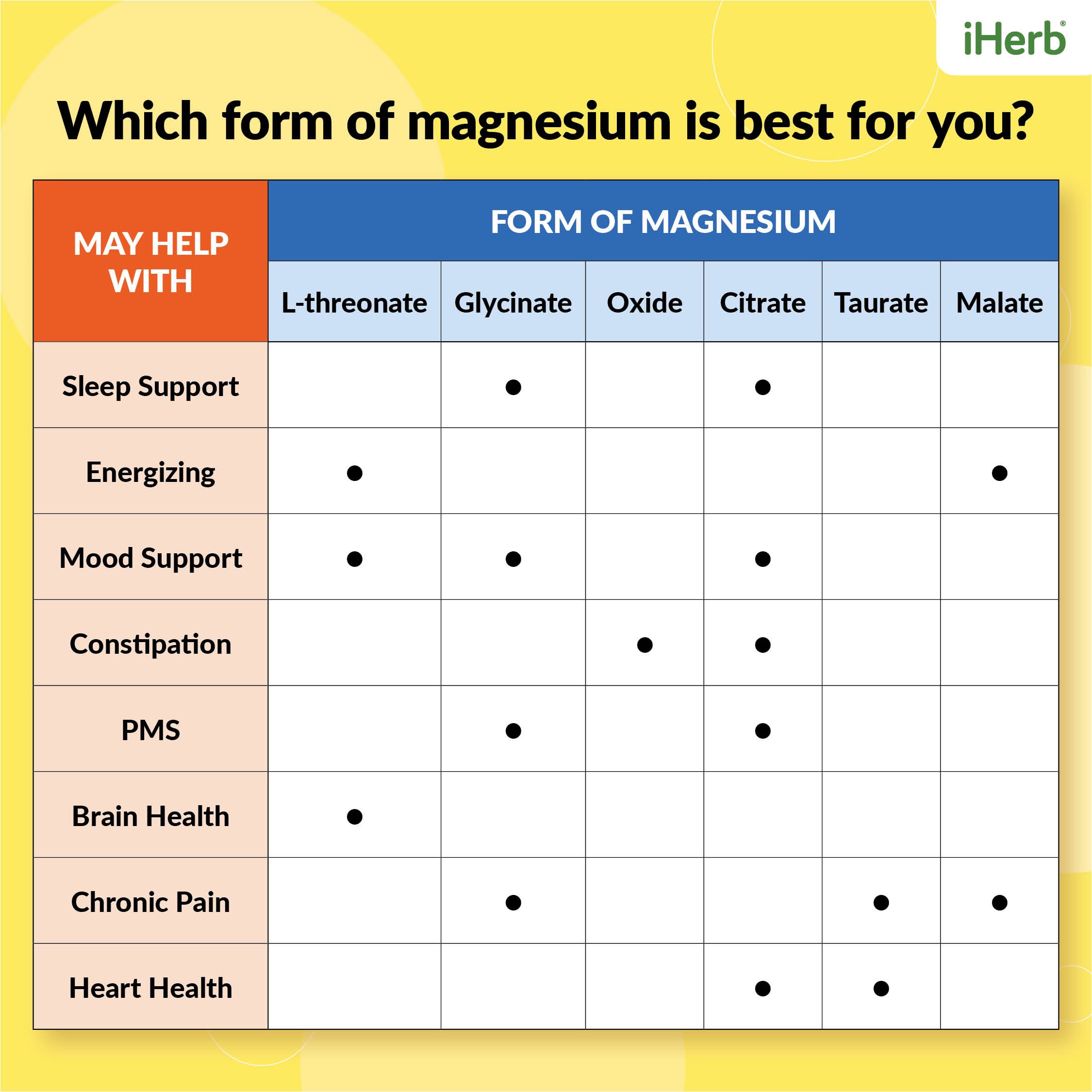4 Different Forms of Magnesium: Which Is Best For Your Goals?
DISCLAIMER:This blog does not intend to provide diagnosis...
- In this article:
- How Much Magnesium Should We Get Daily?
- Foods High In Magnesium
- 4 Different Forms of Magnesium
- Check The Ingredient List
- Define Your Health Goals

Magnesium is a mineral that is necessary for human life. The average adult body contains 25 grams of magnesium as part of the human body makeup. This mineral is required for hundreds of body processes and is also an electrolyte. This is one reason you may see magnesium included in some electrolyte supplements. In addition, magnesium supports a healthy inflammatory response, creates and maintains muscle, offers more stable blood sugar control, aids metabolism may boost energy and keeps bones healthy and strong.
How Much Magnesium Should We Get Daily?
The recommended dietary allowance (RDA) for magnesium is 400-420 mg for men and 310-320 mg for women varying by age. This is quite a lot of magnesium considering the smaller amount available in our food. High levels of magnesium are not common in food. Here is the shortlist of foods that are rich in magnesium and provide close to (or more than) 20% of our RDA.
Foods High In Magnesium
- Swiss chard (cooked)
- Spinach (cooked)
- Pumpkin seeds
- Sesame seeds
- Quinoa
- Cashews
- Sunflower seeds
- Barley
I actually cannot guarantee the accuracy of this list as it depends on how and where the food was grown. The magnesium content in food depends on the soil condition. Plants get their richer levels of magnesium from more fertile soil, and these soil conditions are often unknown when purchasing food at the grocery store.
As you can see, many of us may need supplemental magnesium depending on our goals, health, and diet. In addition, those who take high levels of vitamin D may also require more magnesium in their diet or in supplement form. As the body works to process high levels of vitamin D, magnesium may become deficient. You may consider asking your doctor which options may be right for you.
So, which form of magnesium should we take? There are so many options! Let’s have a look at the most popular, yet very different forms of magnesium and which may be right for your goals.
Can Magnesium Help Improve Sleep?: Read more.
4 Different Forms of Magnesium

1. Magnesium Glycinate
I will start off with what is perhaps my favorite form of magnesium: magnesium glycinate. This means that magnesium is combined with the amino acid glycine. Overall, the glycinate form absorbs better and is least likely to cause digestive distress. More commonly, you will find magnesium glycinate in capsule form. Sometimes you can find magnesium glycinate powder which I prefer as magnesium is a bulky supplement. This means that in order to get an effective dose, you have to take a greater quantity of pills. So, instead of taking a handful of magnesium pills, you can take a little powder mixed in with a little water more easily. The additional water also works well as magnesium draws water into the stool in the digestive tract.
Uniquely, magnesium glycinate is known for its ability to affect our neurological health. Research has shown that 150 to 300 mg of magnesium glycinate (or mixed with a magnesium taurinate) taken a few times per day has shown marked improvement in cases of depression, anxiety, and memory loss. The mechanism of action is still unknown. One hypothesis is that those low in magnesium may suffer more from mental health issues. However, magnesium blood tests have not shown this to be the case. Research hints that it may be possible people begin feeling symptoms before blood tests show a deficiency.
Overall, if you are looking for a magnesium option that may provide the most calming and restful effect in the evening or using it for overall mood support, a magnesium glycinate may be your better option. In addition, you may see some anti-inflammatory support from the glycinate form as an added bonus!
2. Magnesium Citrate
Magnesium citrate is my second favorite option as it is more affordable, absorbs well, and gently helps to loosen the stool if that is your desired effect. If you suffer from occasional constipation, this is likely your best option. I prefer to use magnesium citrate in powder form so that the extra water will help promote regular bowel movements.
You might get the calming effect from magnesium citrate, but not quite as much as you would from magnesium glycinate. This is why you may still see magnesium citrate products advertised for the purpose of relaxation.
Uniquely, magnesium citrate has been studied for migraine prevention. However, research has found that for the prevention of some types of migraines or for lessening symptoms, pretty high doses are likely needed (around 600 mg). This is yet another reason to speak with your doctor before beginning a more significant supplement like magnesium citrate. It is often difficult to tolerate such large doses of magnesium without causing digestive discomfort.
It’s important to note that excessive magnesium intake may create an imbalance in calcium levels. This is one reason you may see some magnesium supplements that have a small amount of calcium added to them for balance. This may be more suitable for those taking higher levels of magnesium.
Last but not least, magnesium citrate has also been researched for PMS symptom management. A small amount of research has shown a mild reduction in symptoms from PMS when taking oral magnesium citrate. A woman’s magnesium and calcium levels fluctuate throughout her menstrual cycle. During the premenstrual phase, magnesium levels may become deficient or at their lowest, and researchers believe added magnesium may reduce symptoms.
3. Magnesium Oxide
Magnesium oxide is my least favorite option, as research has shown it absorbs worse than a citrate or glycinate form. Magnesium oxide is the most affordable form of magnesium you will find, and it is the most common form found at many grocery stores. It commonly comes in tablet form.
Since magnesium oxide has poor bioavailability (absorbs poorly), you may need a higher effective dosage. Since you may have to increase the dose to see results, it is more likely you may experience negative digestive side effects.
4. Magnesium Carbonate
Magnesium carbonate deserves a mention as it is a popular choice for myself and my clients. Magnesium carbonate turns into magnesium chloride in the stomach and may offer stomach-soothing antacid benefits when drinking the supplement from a powder form. Therefore, I prefer magnesium carbonate in a powder form that you mix in with a little water and drink as a supplement.
Magnesium carbonate plus citric acid forms magnesium citrate when mixed together in water. This is why you may see many powder magnesium carbonate forms with citric acid listed as an ingredient. When the water is added to the mixture, your drink has some bubbles and fizz showing this chemical reaction occurs. Over the course of a few minutes, your drink will turn into magnesium citrate. If you want the drink to settle your stomach, consume when it is still fizzy. If you prefer to get more of the highly absorbable citrate form, allow the bubbles to settle, and then drink it.
Overall, magnesium carbonate plus citric acid is one of my favorite options as it is enjoyable to drink and offers a nice calming feel to the stomach.
Check The Ingredient List
Lastly, check your magnesium supplement for other additives or fillers to determine what is right for you. Some powder supplements add stevia, xylitol, sucralose, monk fruit, or other sweeteners to enhance the flavor. I prefer a natural, no-sugar option like stevia or monk fruit. However, it is your choice and depends on your personal goals and preferences!
Define Your Health Goals
Are you looking for improved digestion? Or, perhaps, you want more restful sleep. Maybe you are prone to headaches or are looking for better support for exercise and muscle repair. Define what result is important to you. Then, you may be better able to decide which form of magnesium is right for you when speaking with your doctor. Will your choice be citrate, glycinate, carbonate, or another form of magnesium? Take a look at a few different options and find your new favorite magnesium supplement.
The Top Ten Uses of Magnesium: Read more.
References:
- Office of Dietary Supplements - Magnesium. Accessed March 23, 2021. https://ods.od.nih.gov/factsheets/Magnesium-HealthProfessional/
- Eby GA, Eby KL. Rapid recovery from major depression using magnesium treatment. Medical Hypotheses. 2006;67(2):362-370. doi:10.1016/j.mehy.2006.01.047
- Costello RB, Elin RJ, Rosanoff A, et al. Perspective: The Case for an Evidence-Based Reference Interval for Serum Magnesium: The Time Has Come12345. Adv Nutr. 2016;7(6):977-993. doi:10.3945/an.116.012765
- Köseoglu E, Talaslıoglu A, Gönül AS, Kula M. ORIGINAL ARTICLE The Effects of Magnesium Prophylaxis in Migraine without Aura.
- Ozolinya LA, Анатольевна ОЛ, Overko AV, Вячеславович ОА, Bakhodurova KA, Азизовна БХ. The role of magnesium in the treatment of premenstrual syndrome. VFSnegirev Archives of Obstetrics and Gynecology. 2020;7(2):102-107. doi:10.17816/2313-8726-2020-7-2-102-107
- Rylander R. Bioavailability of Magnesium Salts – A Review.

 By Nicole Morgan RDN, LD, CLT
By Nicole Morgan RDN, LD, CLT


